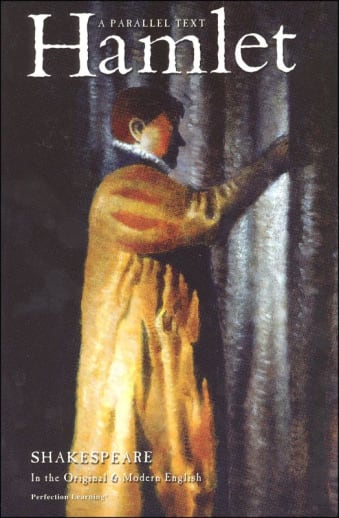I realize this may sound like an exaggeration, but after perusing this sample of Romeo and Juliet, I almost wished I could go back to high school and study it again, in this format! It's extremely well thought out and put together. With this program, I feel like I could actually teach my younger siblings Shakespeare, and it would be an experience that we could all enjoy. There are four components to each play: a text, a teacher's guide, a student workbook, and a teacher workbook. The text is unique and contains a lot more than just an unabridged version of the play. Rather, the text contains two versions of the play, with the unabridged, original version on the left-hand side of each two-page spread, and the modern translation printed on the right-hand page. Both versions are laid out identically with regard to format, so you won't have to flip to another page to keep up with the other translation. Ideally, students will read the original form through, and then read the modernized translation so they can go back to the original, and realize "oh, that's what he meant!". The play is divided up by act, with each act featuring "before you read" questions, a discussion of the literary elements found in that act, a list of vocabulary (with definitions) that may be unfamiliar to the student, and an act summary. After each act in the text, you'll find a handful of discussion questions, a return to the literary elements found in that act that ask the students to find examples from the text, and a list of writing prompts. I'm pretty impressed at the depth of the questions included; they ask students to interpret character's actions to determine their character, analyze their behavior, compare and contrast characters, ask them how their feelings for the character have changed, and much more. The literary element questions and writing prompts are just as involved, asking students to find examples of foreshadowing and hyperbole, or asking students to look up the rules for writing a sonnet and write one, or to choose a quotation that best characterizes a scene, and write about its significance. The end of each text features discussion questions, literary analysis questions, and writing prompts for the whole play, as well as "extras," like group activity suggestions, and background about Shakespeare's life, and the Globe theater.
The text teacher's guide "fills in all the blanks" from the student text, and includes true/false "anticipation questions," pre-reading discussion questions, teaching suggestions and suggested activities, an act summary, detailed answers to the post-reading discussion and literary element questions, suggestions for the writing prompts, and a defined vocabulary list for each act. A reproducible vocabulary quiz is also included for each act, as is an essay quiz. The vocabulary quiz contains matching, multiple-choice, and short answer questions on the vocabulary, while the essay quiz asks short essay questions at both a literal level and an interpretive level. The end of the guide contains the answers to the final discussion and literary questions, as well as an end-of-play test including matching, true/false, multiple-choice, and essay questions about the play as a whole.
Really, you could study a play very thoroughly simply by using the text and the teacher's guide, and if reading, discussion, and essay questions are all the further you want to take each play, I would highly recommend this. However, there is also a workbook component available that emphasizes both the reading comprehension aspect of the play and explores open-ended, creative questions as well. For each scene, or group of scenes chunked together, the student will answer reading questions for that section, which are primarily reading comprehension questions, with references to the text for help finding the answers. A "response log" follows the reading questions, and asks the students open-ended questions about issues in the text. For example, at the beginning of Romeo and Juliet, they are asked to imagine what may have originally caused the conflict between the two families, and think about what may resolve it. Other response questions are equally thought provoking, and may ask the student to explore the different characters using graphic organizers, to make a list of symbols and phrases of love in our times, to write questions you may want to ask the characters, and much more. The end of each act lists discussion questions for short essay responses. These are different than the response questions in the text, and further flesh out the study of each scene. The end of the workbook offers suggestions for extension activities and additional writing assignments, based on the play. The workbook teacher's guide offers additional teaching helps and copies of the student worksheets with answers provided.
Altogether, I think these are the most thorough and easy-to-use studies on Shakespeare's plays that I've run across in a long time. I love that the text is provided in two versions, so you can really understand what's going on in the play without turning to another source constantly to look up words and phrases. I also enjoy the quality and the depth of the discussion questions, and I appreciate the lengths that the authors have gone to, to include a study of literary elements in the plays. Often, comprehension is the most important thing studied in literature guides, and literary elements are left along the wayside. As I mentioned above, if you do not want to put the expense and effort into a full-blown mini-course on each play, you will get along quite nicely with the text and the teacher's guide. However, if you would like to focus more on comprehension and writing, the workbook is a terrific complement. Whichever option you choose, I think you'll agree that this is an excellent and high-quality course that makes teaching Shakespeare a little easier for both the teacher and student. - Jess

